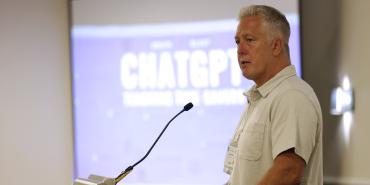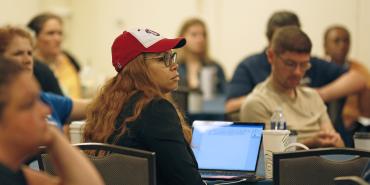Artificial intelligence, or AI, is already pervasive in our lives. But the introduction of platforms like OpenAI/ChatGPT has the education world questioning how it should be used or if it should be used at all. In the AFT TEACH workshop “Use It or Block It? Using OpenAI in the Classroom,” presenters Peter Guyon and Kathleen Torregrossa addressed this question in front of a group of educators—some of whom were already using AI in the classroom, while others were curious about its potential.
“Our very first experience with [AI] was like, what is this going to do to teaching and learning?” asked Torregrossa, who is the coordinator of professional learning, evaluation and mentor programs, and an instructional coach for the Cranston (R.I.) Public Schools. In the beginning, the technology team was ready to block AI in the school district, said Torregrossa. But within a few hours, they did a complete turnaround. “We have to convince the [school district] to keep this and have to show them what we can do with this instructionally ... [because] what our teachers can do with this is going to be amazing.”
The speakers discussed the research they have compiled over the last few years and showed participants the platforms that are accessible to them. The presenters also shared tips with workshop participants on how they might persuade their school administration to allow them to experiment with these platforms in the classroom.
“As teachers, our job is to provide students with the skills necessary to be functional in the workplace when they leave us,” said Torregrossa. “Guess what? The workplace already has AI, so we can’t ignore it. We should try to figure out … the best ways of incorporating it in the classroom.”
Torregrossa described AI as a simulation of human intelligence but noted that it has missing components. “It doesn’t have creativity. It doesn’t have empathy. It doesn’t have compassion. It’s an algorithm that takes data and chooses to make new data. It’s just an algorithm,” she said. “It’s not going to go away, it’s only going to get bigger and better, ... so we have to figure out how we can benefit from it.”
Guyon, who is an instructional coach coordinator with the Cranston Public Schools, shared a range of ways educators can use various AI platforms in the classroom, from creating lesson plans to generating tests and quizzes. He also explored OpenAI/ChatGPT in real time for participants, using prompts that have been used in the classroom.
Torregrossa allayed the fears of any educators who are worried that AI like ChatGPT might take away jobs, noting that these platforms are not replacing teachers: “This helps you personalize your instruction based on what your curriculum standards are. You’re still doing the teaching.”
[Adrienne Coles/Suzannah Hoover, photos]


